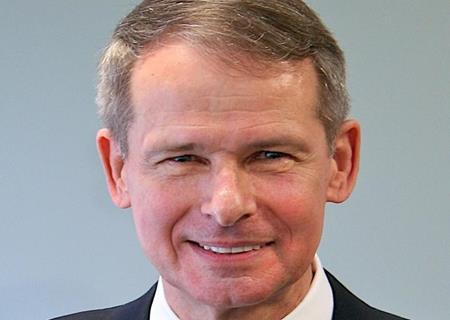
29 Jun Peter Pace

Speaker: Peter Pace
Chairman, Joint Chiefs of Staff (2005-2007)
Topics:
- Leading Up
- Cyber Security – Global, National, Organizational, and Personal Vulnerabilities
- Global Security: A Lap Around the World
- Non-Political Advice in a Very Political Environment
General and keynote speaker Peter Pace shares his views on leadership and the importance of being guided by ethics, motivation and responsibility as he provides insight into our greatest national, global and cyber security threats.
As Chairman of the Joint Chiefs of Staff, General Peter Pace was entrusted with leading the ever vigilant mission to maintain the highest level of security for the U.S. and its allies throughout the world. With more than 40 years of leadership experience as his guide—from Vietnam combat veteran to presidential military advisor—Pace impresses upon his listeners the vital role of maintaining personal integrity and using a moral compass to anchor and direct their lives, no matter their sphere of influence. In his compelling presentation, Pace provides an analysis of today’s gravest domestic, international and cyber terrorist threats, how predictable military responses aren’t always the answer, and how each organization must mitigate their own level of risk.
Believing that genuine leaders have the responsibility to mentor and motivate, as a speaker Gen Peter Pace empowers audience members to rise and meet the current challenges everywhere—on the battlefield, in the boardroom and in life.
Leading Up
While we all understand that the boss has a responsibility to lead an organization’s employees, rarely do we focus on the employees’ responsibility to lead the boss. In addition to mentoring and motivating their subordinates, truly effective leaders value the perspective of all members of the team, and encourage subordinates to lead up – to share information up the chain of command in a way that helps an organization’s leaders make timely, accurate decisions.
A master at serving many masters, Pace demonstrates how to think through the consequences of multiple competing priorities, see the bigger picture, and communicate that strategic analysis up the chain in a way that is clear, precise, and useful. In fact, Michael Useem, Director of the Center for Leadership and Change Management at the Wharton School devotes a chapter to Pace in his book, Leading Up, highlighting Pace’s efforts to reconcile the conflicting priorities of six bosses by keeping them well informed and challenging their instructions when necessary.
Amid today’s fragile global economy, corporate restructuring is commonplace, as managers and leaders are continuously challenged to do more with less. In this inspiring discussion, General Pace shares insights and personal examples about leading in both directions, to include:
- Embracing the job you didn’t want
- Determining who ‘owns’ a decision – and then making it!
- Navigating between the organization’s vision and your own personal goals
- Speaking up in a way that challenges assumptions but not authority
- Listening to subordinates and encouraging differing points of view
- Checking your moral compass and preparing for ethical decisions before they arrive
Cyber Security – Global, National, Organizational, and Personal Vulnerabilities
Cyber defense, cyber attack, cyber warfare – the terms are prevalent and yet, what do they really mean to you and your organization? Little is understood about this unique and ubiquitous threat to our national and personal security. Yet defending the homeland means more than protecting our airports, railheads, nuclear plants and government buildings. Power grids, banking data, telecommunications, and personal identity records are all at risk.
The US Cyber Command has budgeted billions of dollars this year for cyber defense systems – how much is enough to protect your organization? If your business depends even in part on computers, you are vulnerable to a cyber attack from hackers, criminal elements, even state-sponsored terrorists.
Estonia, the CIA, and Google have one thing in common – they were breached by hackers. The cost in restoring lost data is significant, but the cost of restoring lost confidence is immeasurable. Is your organization prepared to thwart a cyber attack?
Even as individuals, we are not immune. For instance, PayPal’s response to Wikileaks’ unauthorized release of classified documents in Sweden prompted hackers to disable PayPal temporarily preventing online purchases.
Combining his vast military experience with unprecedented access to state of the art IT security expertise, Gen. Peter Pace explains this invisible threat, and what nations, businesses and individuals can do to protect themselves.
Global Security: A Lap Around the World
As our nation’s leaders struggle to determine how much national defense we can afford, General Pace offers a focused and detailed assessment of what’s beyond our borders that deserves our attention, and perhaps more critical analysis. Pace goes beyond the conventional threats and predictable military responses and provides a candid look at the current threats to national security. From cyber attacks to narco-terrorists, the defense of our nation and our allies is exponentially more complex following the attacks of 9-11, which demonstrated that America has enemies without boundaries.
Yet how do we fight a war against an enemy inside of a country with which we are not at war?
How does the advent of instant information through social and mainstream media impact our ability to defeat our enemies, maintain operational security, and sustain support on the home front?
How much of our attention – and national resources – should be used to address global security issues? And what is at stake if we turn our focus inward, hunker down and defend from our borders? The cost of war is high, but how do we calculate the cost of not going to war?
No longer something relegated to our military forces, national security involves us all.
From the safe export of millions of dollars in goods and services, to the protection of the smallest business payroll, no matter what your line of work, you are – and will continue to be – impacted by national security decisions.
In this tailored talk, Pace takes you on a lap around the world. Country by country, he discusses the most serious global threats, identifies those that most affect your business and/or your industry, and shares what organizations must do to assess and mitigate the risks.
Non-Political Advice in a Very Political Environment
A key ingredient to our system of government is civilian control of our military. As Chairman of the Joint Chiefs of Staff, General Pace was responsible for providing his unvarnished insights and best military advice to the Commander in Chief, the Secretary of Defense, the National Security Council, the Homeland Security Council, and when asked, the Congress of the United States. In a discussion that transcends any partisan political debate, General Pace explains the chain of command and the value of this civil/military relationship, demonstrating how non-political advice plays an important role in our government process, even in (especially in) a very political presidential election year.
Using real world examples from perspective gained in senior most military leadership roles, General Pace adds valuable insight on how to approach challenges that are familiar to any organization. From navigating multiple military and national security proposals in response to the latest headlines, to the professional working relationship between the President, the National Security Council, the Secretary of Defense, and the Chairman of the Joint Chiefs of Staff, General Pace shares “a day in the life” view, detailing what it’s like to provide strategic guidance on an organization with 2.6 million members, and a budget in excess of $500 billion dollars. Pace describes the DOD budget process, how priorities are addressed, and the impact of shortfalls or cost overruns. He makes recommendations to change the interagency process in order to more effectively and efficiently carry out the orders of the Commander in Chief.
How does this apply to your business?
– Crisis du jour—how will your organization hold up in the wake of bad news? Do you have a crisis response plan that addresses the media attention as well as the longer term implications for the company’s culture and your ability to weather the storm?
– Departmental rivalries – how to use leadership’s clear vision to navigate beyond conflicting interests and stove piped perspectives; how to work inside a process while still presenting your case for change.
– A day in the life of the Chairman/CEO — the importance of time, mentors, access, meetings, responsibilities
– Prioritizing for budget shortfalls – The need to address competing priorities against a shrinking budget, and to be part of the solution, not just part of the discussion.



